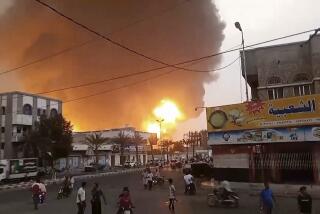Girl, 14, survives Yemeni jet crash; plane’s safety had been in question
CAIRO — European aviation authorities had raised safety questions two years ago about the Yemeni Airbus A310 jetliner that plunged into rough seas Tuesday with 153 people aboard on its approach to the island nation of Comoros in the Indian Ocean.
A 14-year-old girl plucked from the waves and debris appeared to be the lone survivor as military boats, planes and rescue teams fanned out along the coast off the Comoro capital, Moroni. The Airbus, with a crew of 11, was flying in strong winds as it prepared to land at the city’s Prince Said Ibrahim International Airport hours after leaving the Yemeni capital, Sana.
The plane, which lost radio contact with the control tower and vanished about 12 miles offshore, was carrying 66 French nationals and other passengers, including Comorans, a Palestinian and a Canadian.
Flight 626 originated in Paris and stopped in Marseille before traveling on to Sana, where passengers switched to the Airbus A310-300. That jet, which was 19 years old and operated by Yemen’s national carrier, Yemenia, had raised suspicions earlier among European safety inspectors.
In 2007, French transportation authorities barred the plane from French airports following a safety review that found problems with technical equipment.
Inspectors “noticed a certain number of defects. Since then the plane had not returned to France,” Transportation Secretary Dominique Bussereau was quoted as telling French TV. “The company [Yemenia] was not on the blacklist but was subject to stricter checks on our part, and was due to be interviewed shortly by the European Union’s safety committee.”
French authorities did not go into detail about the nature of the defects, but Yemeni officials insisted they were minor.
In 2008, the European Union asked Yemenia to take “corrective actions” to improve safety performance. It was unclear what those actions were, but at a news conference EU Transport Commissioner Antonio Tajani said Tuesday that Yemenia had been reviewed by safety authorities and the company was not banned from operating in Europe.
“The airline wasn’t on the [EU] blacklist because it had passed the checks,” Tajani said. “After today’s accident we shall be contacting the company” to reconsider whether to add it to the list.
Tajani added that the flight originated in Paris with an Airbus A330 that met European safety regulations. He said the switching of planes in Sana was beyond the EU’s jurisdiction. “We cannot control what happens outside the European Union,” he said.
In a statement, Airbus said the jet that went down had logged 51,900 flight hours. Yemeni Transport Minister Khalid Ibrahim al-Wazir told Reuters that the plane was checked in May: “It was a comprehensive inspection carried out in Yemen . . . with experts from Airbus. It was in line with international standards.”
Yemen’s official news agency, Saba, said preliminary indications were that bad weather, including severe gusts of 71 mph, caused the crash. Bussereau told reporters that unconfirmed information suggested the plane pulled out of its first landing approach and was attempting a second when it slammed into the sea.
The bodies of at least five victims had been recovered, according to Yemeni authorities. The 14-year-old survivor was reportedly traveling with her mother back home to her village in Comoros. A rescue worker interviewed on Europe 1 radio said the girl was spotted swimming in choppy water amid bodies and debris. Earlier reports had described the survivor as a 5-year-old boy.
“Bodies were seen floating on the surface of the water and a fuel slick was also spotted about 16 or 17 nautical miles from Moroni,” senior Yemeni civil aviation official Mohammed Abdul Qader told reporters in Sana. “Weather conditions were bad. The sea was rough.”
Comorans and French nationals who had flown Yemenia had complained to the French government about what they regarded as questionable safety practices, such as passengers forced to sit amid luggage strewn about the aisles and unhygienic conditions.
An association known as SOS Voyages to Comoro was formed to push for improved standards on Yemenia, owned by the poorest Arab nation.
“French authorities didn’t listen to us,” Nassurdine Haidari, president of the Assn. of Comoro Frenchmen and a deputy assistant to the mayor of Marseille, told reporters. “We alerted all the French airline companies . . . about these reject planes. We’ve been denouncing this catastrophic situation for six months.”
Flight 626 is the second Airbus to plunge into the ocean in the last month. All 228 people aboard an Air France Airbus A330 were killed when the plane went down in the Atlantic off the coast of Brazil on May 31.
Comoros, a volcanic archipelago off the eastern African coast, proclaimed its independence from France in 1975. Money sent home by Comorans living in France is an important part of the tiny nation’s economy. Many of the passengers on the doomed flight were Comoran workers traveling home to spend the summer holidays, said Qader, the Yemeni civil aviation official.
Yemenia is Yemen’s national carrier, with a fleet of about 15 planes, including six Airbuses. The company has been leasing the Airbus that crashed from the International Lease Finance Corp., based in Los Angeles. Yemen owns 51% of Yemenia and Saudi Arabia controls 49%.
--
Special correspondent Devorah Lauter in Paris contributed to this report.
More to Read
Sign up for Essential California
The most important California stories and recommendations in your inbox every morning.
You may occasionally receive promotional content from the Los Angeles Times.











